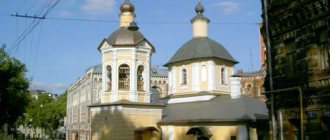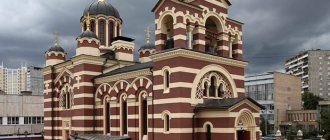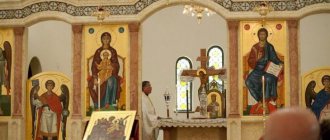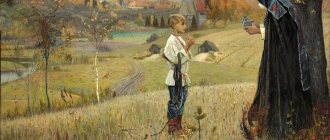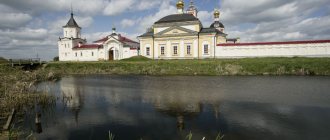The temple on Khodynka Field rises majestically. Once upon a time it was a simple liturgical tent with a camp altar and a post for bells.
Privates and officers of the summer camp of the Moscow garrison came here to take part in the Liturgy with prayer and faith. Today the temple is the main military shrine of Moscow with a parish of more than one and a half thousand.
Temple of St. Sergius of Radonezh on Khodynskoye Field
The temple complex on Khodynka combines a temple - the chapel of the Archangel Gabriel and the temple of St. Sergius of Radonezh.
It so happened historically that in one place the memory of the aviators who died on the Khodynskoye Field was immortalized and the main military temple of Moscow was erected.
Temple complex on Khodynka
A Sunday children's school and a cultural and educational center are comfortably located under the domes of the temple. A choir is organized for parishioners, as well as various sports sections and applied arts clubs.
I would like to note that the rector of the church, Archpriest Vasily, is a big fan of football, and he himself is not averse to kicking the ball in his spare time.
The cultural and educational center of the temple complex hosts musical evenings, applied master classes, and creative meetings.
In the summer of 2021, a warehouse for the volunteer movement “Happiness” opened on the territory of the temple. Volunteers and caring people provide material assistance to those in need.
The building has an assembly hall, workshops, a refectory, a sacristy, and a games room.
Archpriest Vasily Biksey, rector of the temple complex on Khodynka, leads the Divine Liturgy
The history of the creation and construction of the temple begins in the 19th century
The need to build a church arose when the number of the Moscow military garrison, which had located its camp on the Khodynskoye field, began to actively increase. The tent in which liturgies were held for the soldiers could no longer accommodate everyone.
1893
year of construction of the Temple on Khodynka Field
However, chance played a key role in the decision to build the church.
In 1891, the sovereign's son Nikolai Romanov traveled around Japan. In one of the cities, an attempt was made on his life. It was a miracle that Nikolai Alexandrovich survived. It was after this incident that the command of the Moscow garrison made the final decision to build the Church of St. Sergius of Radonezh.
The temple on Khodynka Field was erected in 1893. The completion of construction coincided with the five hundredth anniversary of the death of the abbot of the Russian land, St. Sergius of Radonezh.
The author of the project was Ivan Khorodinov, a Moscow architect.
The church was built with donations from parishioners. In total, about sixty thousand royal rubles were spent on construction.
It was an unheated log house made of pine logs, built on the edge of the Khodynskoye field. In the winter, for heating, a stove was brought into it. Honorable citizens donated icons and utensils to the parish.
The Church of St. Sergius of Radonezh became the main military cathedral of that time.
Moscow - camp church of St. Sergius of Radonezh, 1890
Description of the church building
By the specified date, they managed to complete the construction of the walls. But there still remains finishing work, installation of bells and erection of crosses. Thus, the Church of St. Sergius of Radonezh on the Khodynka Field was completely ready only the following year, 1893. The consecration ceremony took place on May 23 and was conducted by the bishops of Dmitrov and Mozhaisk, as well as the abbot of the Trinity-Sergius Lavra.
In total, construction cost sixty thousand royal rubles. The temple, made in pseudo-Russian style, was designed to accommodate 1000 people. In the first project it was intended to be single-throne. Subsequently, the architect laid out two side aisles. The main altar is dedicated to Sergius of Radonezh. The chapels were named after St. Nicholas (in honor of the miraculous salvation of the Tsarevich) and Mary Magdalene and Alexander Nevsky (in commemoration of the 25th anniversary of the marriage of the imperial couple - Alexander III and Maria Feodorovna).
In winter, services were held in one of the naves, since it was the only one heated in the wooden building. Houses for the priest, deacon and guardhouse were built next to the church. The entire complex was surrounded by a metal fence.
St. Sergius is a righteous example for soldiers
St. Sergius was called by the Lord to the Russian land in difficult times, when the Tatars came to Rus' - the Mongol yoke and brought a lot of grief. Imminent destruction threatened Rus'.
October 8
day of St. Sergius, abbot of Radonezh
St. Sergius came to strengthen and raise the moral strength of the Russian people, to set a bright example of pious life and conscientious work.
It was these qualities that were called upon to support the spirit of the soldiers of the Moscow garrison and set a righteous example. Therefore, it was decided that the temple on the Khodynka field would be erected in honor of St. Sergius of Radonezh.
Holy Venerable Sergius of Radonezh
Story
The church has a very interesting history of appearing just over a hundred years ago. The first monastery was built - the Temple of the Quick Hearer in Moscow in the late 90s of the 19th century in the area of the Great All Saints Grove - on the Khotynka River. The construction was carried out at the expense of the merchant T. P. Gorodnichev.
Initially, a summer military hospital was located here. And the church was built under him - in honor of St. Panteleimon.
The first building of the monastery was a small wooden frame. An iconostasis was made inside - in 1 tier, as well as an altar. The capacity of the temple at that time was only 20 people, which was not enough for an army of 300 soldiers.
Therefore, in 1901-1902 a large stone temple was erected. It was erected under the care of State Councilor I. A. Kolesnikov.
During the revolution of 1917, the monastery ceased to function as a religious one and became simply a warehouse. It was at this time that the wooden church was demolished and the bell tower of the stone church was dismantled.
After a long absence of repairs, complete desolation, and subsequent use of the building as a warehouse for semi-precious stones, in 1992 the church was again handed over to believers.
It was from this time that services in the monastery were resumed, the bell tower was restored, the refectory and Sunday school buildings were added, and a fence was built around the perimeter of the yard.
In 2001, Patriarch Alexy II visited the Church of the Quick to Hear (October Field).
The temple was demolished during Soviet times
In 1910, an airfield was laid out on Khodynskoye Field, hangars and workshops were built. The first aircraft were tested here. Pilots took new aircraft models into the air, risking their lives in the process. Before the flight, they went to the temple for a blessing.
Khodynka field 1918
More than a hundred aviators died during the tests.
With the Bolsheviks coming to power, the temple on Khodynka Field was closed. It was planned to house a reading room or party lecture hall in the building. But in the end it was simply dismantled for firewood.
During the Great Patriotic War, our planes took off from the airfield on Khodynka. During the years of Soviet power, tests continued to be carried out here. Among the dead testers was Hero of the Soviet Union Valery Chkalov.
Unfortunately, for such a long time, the memory of the dead pilots was never immortalized.
Revolutionary period
The irony of fate was that even after the October Revolution, Khodynskoye Field was used as a location for military camps. Of course, there was no question of divine services. The temple complex of St. Sergius of Radonezh on Khodynka was closed in 1919. The camp commandants thought about how to adapt the church to new, revolutionary needs. It was planned to organize a party school, a reading room and even a stage for concerts in it. But it was all in the memos.
In fact, the church was plundered by unknown people. The inventory of 1921 shows the deplorable condition in which the temple was then. Broken icons, banners, broken glass, parts of chandeliers and candlesticks were scattered on the floor. In the mid-1920s, what survived was transferred to the courtyard of the Ufa Archangel Michael Monastery and the parish church in the village of Belaya Tver province. But even the tattered walls without crosses and domes were an eyesore for the new government. Since “the presence of the church has a detrimental effect on political work with the Red Army soldiers,” the building was completely demolished.
The revival of the temple began in 1996
In the period from 1996 to 2000, a church community was created in Moscow - the chapel of the Archangel Gabriel in the name of perpetuating the memory of the fallen testers and the parish of the Church of St. Sergius of Radonezh, praying for the restoration of the main military cathedral.
In 2012, with the blessing of Patriarch Kirill of Moscow, both parishes united.
Prayer service for the restoration of the Temple of St. Sergius of Radonezh
Having received permits, they plan to begin construction of the temple complex.
They were going to build a temple on Khodynka field and a temple-chapel from different sides of Khodynka. The district administration, having reviewed the projects, proposed combining construction on one site.
Land scandals
The cross at the site where it was decided to build a new church in honor of St. Sergius of Radonezh was installed in the summer of 2012. At the same time, the first divine service took place - for now in the open air.
But the land on which the construction was planned belonged to the Russian Ministry of Defense. It challenged the construction of the temple in court. A conflict has arisen. Residents of the surrounding houses also opposed the construction.
In the end, the court found the Ministry of Defense to be right. The construction that had begun was declared illegal.
Then, in the spring of 2014, it was decided to look for a new place to build a temple. It was planned to be built at the beginning of the former runway. Nearby, a chapel in honor of the Archangel Gabriel, dedicated to the fallen test pilots, was almost erected. It was consecrated in October 2014. And in December, all documents were drawn up for a small plot of 0.5 hectares for the construction of the Church of St. Sergius of Radonezh. It is located opposite the Sports Palace.
Construction of the new temple took place in 2015
The communities had to go through many obstacles to build the temple complex on Khodynka
Since 2014, a temple has been operating on the territory of the complex - the chapel of the Archangel Gabriel, erected in memory of the heroes - the aviators.
But the construction of the temple on Khodynka Field began in 2015 under the “200 temples” program.
The white-stone beauty grew up in less than two years and fit perfectly into the industrial city landscape. The architect of the temple, professor S.Ya. Kuznetsov took Pskov architecture of the 13th century as a basis.
During the Soviet period, practically no churches were built, so the traditions of temple architecture were partially lost. In this project, the mixture of Russian architecture and modernity gives the building a special harmony, rigor and at the same time, spirituality.
In the fall of 2021, Patriarch Kirill of Moscow and All Rus' consecrated the temple on Khodynka Field.
His Holiness Patriarch Kirill consecrated the Church of St. Sergius of Radonezh on Khodynka Field in Moscow
The Church of St. Sergius of Radonezh is surrounded by buildings of aviation enterprises. There is also a sports palace and a shopping complex here. Residential areas are located some distance away. However, there are always a lot of parishioners, everyone comes to listen to the Rector of the temple, Archpriest Vasily Biksey.
Schedule
Daily morning and evening services in the Church of St. Sergius of Radonezh begin at 9-00 and 17-00, respectively.
The schedule of services can be viewed on the official website of the temple.
Information about services on holidays and a more precise schedule can be found on the official website of the temple.
- Patronal holidays;
- Day of the discovery of the honorable relics of St. Sergius of Radonezh (July 18);
- Day of Saint St. Sergius, abbot of Radonezh, wonderworker of all Russia (October 8).
July 18
day of the discovery of the honorable relics of St. Sergius of Radonezh
What does the church look like now?
Construction began in 2015. During this time, walls were erected, a roof was laid, and five domes were installed. All parish services will be located under one roof: a children's art school, a refectory, sacristies, etc. The final finishing work is currently underway in the temple complex of St. Sergius of Radonezh on Khodynka. Services have been held since Christmas this year. The rector of the church took part in the first festive liturgy, who thanked all the gathered believers for their help and donations to the church. Among other things, he assured that interior painting will be completed by the fall of this year.
You can get to the temple by metro
The temple on Khodynsky Field is located at the address: Moscow, Khodynsky Boulevard, building 6, building 1.
The nearest metro station is CSKA. It is located within walking distance from the temple complex. The CSKA metro station opened in February 2021. Exit from the lobby of the Big Circle Line.
The temple on Khodynka Field rises majestically. Once upon a time it was a simple liturgical tent with a camp altar and a post for bells. Privates and officers of the summer camp of the Moscow garrison came here to take part in the Liturgy with prayer and faith.
Today the temple is the main military shrine of Moscow with a parish of more than one and a half thousand.
By leaving a comment, you accept the user agreement
Temple of St. Sergius of Radonezh on Khodynka Field: description, history and interesting facts
The Church of St. Sergius of Radonezh on Khodynskoye Field has often become the subject of controversy and even land scandals in recent years. But worldly affairs calmed down, and on Christmas Day 2021, the first liturgy was held in the church, which had not yet completed construction. The authorities promise that the temple will be completely restored by the fall of this year. All this causes increased interest in the church on Khodynskoye Field. When was it built and why? When and why was it demolished? Does the current temple correspond to its original appearance? We will talk about this in our article. We will also provide general information on how to get to the temple complex and the schedule of services. We will briefly touch on the vicissitudes associated with the restoration of the church.
History[edit]
At the beginning of the 20th century, for the 1st Grenadier Artillery Brigade of Count Bruce and the 1st Don Cossack Generalissimo Prince Suvorov Regiment, Nikolaev barracks were built near the Khodynskoye Field. According to the project, a church was not envisaged at the barracks, and its construction was financed by the money of the actual state councilor I. A. Kolesnikov. The author of the project was the architect V. D. Adamovich. The church was founded on April 29, 1907. The temple was consecrated on April 5, 1909 by Metropolitan Vladimir of Krutitsky and Kolomna in the presence of Grand Duchess Elizabeth Feodorovna.
The temple was closed in 1922, the building housed a dormitory and then a construction workshop. The heads of the building were demolished, the belfry was destroyed, and the fence was partially dismantled. The temple building was scheduled for demolition in connection with the reconstruction of the Botkin Hospital. However, thanks to the efforts of the hospital’s chief physician, I.P. Kuzin, in February 1990, the church building was transferred by the Frunzensky District Council to the Russian Orthodox Church. The building was freed from production equipment only on January 5, 1991, the same year the temple was consecrated, and restoration lasted until 1996. The most significant contribution to the restoration of the temple was made by its rector, Abbot Irinarch (Grezin), who in 2002 became Bishop of Perm and Solikamsk, now Bishop of Krasnogorsk, vicar of the Moscow diocese.
Divine services
The monastery regularly hosts divine services - services during which prayers and biblical texts are sung or read. Also at this time (especially during holiday services and liturgies) religious ceremonies are performed.
All this allows believers (living in this area of the city, as well as from throughout the capital and other cities) to connect with the Divine, develop faith and love for the Lord and people. The sacrament of communion is especially important.
The main task of services and obediences in the Church of the Quick to Hear on the “October Field” (schedule below) is the wise teaching of Christian believers in the commandments of Christ, introduction to prayer and repentance, meekness and humility. An important aspect of faith in God is also love and gratitude.
Divine services in the monastery are: daily, weekly, annual, holiday. Particularly important are Easter, Christmas, Dormition of the Queen of Heaven, Trinity, in honor of the Icons of the Holy Great Martyrs and others.
They are conducted in this monastery by the rector of the church, Archpriest Alexy Chuley.
